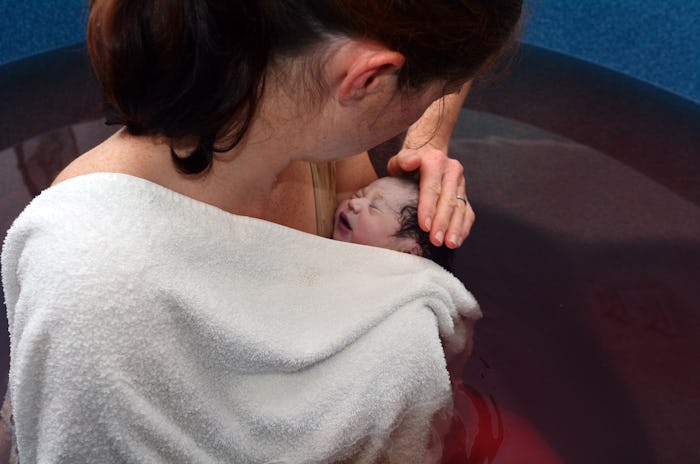Life
Is A Water Birth Safe? Yes, Unless You Suffer From These 7 Risk Factors
Few things in life are as readily stress-relieving as a soak in the tub. And for years, some expectant women have used the inherent relaxing qualities of water to make the labor and birthing process more peaceful. But is a water birth safe for both mom and baby?
Before diving into the safety of this modern birth method, it’s important to know what a water birth is. According to the American Pregnancy Association, a water birth involves a mother giving birth in a tub of, you guessed it, warm water. The APA notes that some mothers will labor in the water and get out for the delivery, while others stay in the tub for the entire birthing process. Sounds pretty relaxing right?
As water births grow in popularity, it’s important to look into the safety of this birthing method. And, as is with many pregnancy topics, the reviews are mixed. A 2014 statement from the American College of Obstetricians and Gynecologists declares that water immersion during the initial stages of labor is reportedly safe and may help decrease labor pain. ACOG also noted, however, that the safety and efficacy of immersion in water during the second stage of labor have not been established. In fact, there may not be any benefits to delivering your child in this way. (It should be noted that the American Association of Birth Centers was concerned that the ACOG and AAP opinion statement did not adequately account for water births attended by skilled midwives.)
Although more research on water births is needed for conclusive results, there have been cases of babies getting a deadly infection after water birth or nearly drowning from breathing in tub water. Underwater delivery may also cause difficulties in the baby’s regulation of body temperature, as well as an increased potential for damage to the umbilical cord.
But don’t let this doom and gloom totally dissuade you from considering a water birth if you’re interested. For instance, certified doula Christine Strainhas tells me in an interview that she had great success with water births for her clients.
“From a doula perspective, every client I have supported through water birth has loved the experience,” she says. “I think waterbirth is a great option that should be more widely available in hospitals.” She does acknowledge, however, that water births are not for everyone.
“Not every woman who desires a water birth will end up having one, so it is important to be flexible and open to the possibility that hey may not actually birth in the water.”
With all of this in mind, it is up to the mother and her medical team to decide if a water birth is the best fit. There are, however, some situations in which a water birth is a definite no-go. Here are seven cases in which a pregnant woman may be unable to give water birth.
1She Has Gestational Diabetes Or Diabetes
According to the Evidence Based Birth study on water births, women who have gestational diabetes may need to leave the tub to avoid an increased risk of shoulder dystocia, a scenario in which the baby’s shoulder gets stuck behind the mother’s pubic bone during delivery. The midwife may need the mother out of the water to help shift positions so the baby may be safely delivered.
2She's Having Twins Or Breech Babies
If you’re having multiples or your baby is breech, then a water birth may not be the best option for you. The Evidence Based Birth study concludes that there is not yet enough data on the safety of choosing a water birth for in these cases, so you may want to err on the side of caution.
3 She Has Herpes
According to the American Pregnancy Association, if the mother has herpes, a water birth may not be recommended because the virus can be transferred in the water. Mothers with the virus should discuss birthing safety with their healthcare provider to lessen the risk of transference.
4She Goes Into Preterm Labor
Again, the American Pregnancy Association does not recommend mothers with preterm labor to attempt a water birth. And according to the Mayo Clinic, infants who are born prematurely may experience problems with breathing and underdeveloped organs, so they may require more immediate medical care during and after their birth.
5She Has A Ruptured Membrane
If you have a ruptured membrane, you may be prone to an increased risk of infection, according to the ACOG’s Committee Opinion on water births. In this case, your healthcare provider may suggest a more traditional birth.
6She Experience An Abundance Of Meconium
If a large amount of meconium appears in the tub, it may indicate that the baby is stressed and likely to gasp underwater, according to the Evidence Based Birth study. And according to ACOG, the risk of a baby aspirating underwater is one of the greatest concerns of water births, due to the risk of drowning or near drowning.
7She Suffers From Toxemia
ACOG does not recommend mothers with toxemia or preeclampsia use water birth method. Preeclampsia is defined by the Mayo Clinic as an elevation in blood pressure that can have serious complications for both the mother and baby. If you have this condition, you will need to discuss the safest way to deliver your baby with your healthcare provider.
